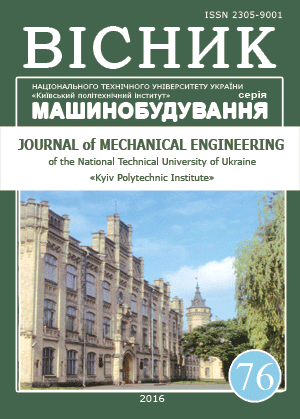MODELING OF LARGE STRAINS. MESSAGE 7. FOUR TYPES OF STRAINS, TOTAL LAGRANGIAN FORMULATION
DOI:
https://doi.org/10.20535/2305-9001.2016.76.66198Keywords:
large strains, thermo-elasticity, plasticity, creep, Total Lagrangian formulation, multiplicative decomposition, algorithm, FEMAbstract
It was considered in previous articles (Reports 1,2,3 and 4) how the idea of Lee's multiplicative decomposition of the elastic-plastic Cauchy-Green deformation gradient can be implemented to a generalized decomposition on the thermal, elastic, plastic and creep deformations gradient; and the admissible forms of the constitutive state equations were established. The objective of the 5-th Reports is to determine which type of the reference configuration 'unloaded' or 'initial' is more suitable in case of thermo-elasticity with respect to general hyper-elastic postulates. In the 6-th Reports variant of effective variant of algorithm for a solution of boundary problems of thermo-elastoplasticity with large strains is justified at Total Lagrangian formulation. The purpose of this Message – to offer version of effective algorithm for the solution of thermoelasto-plasticity and creep boundary problems with the large strains at Total Lagrangian formulation. Applied proved on the basis of the second law of thermodynamics creep theory, multiplicative decomposition of a gradient deformations Koshi-Green, Total Lagrangian formulation and the approach when elastic, plastic and creep strains are determined concerning the "unloaded" condition. A material – isotropic metal. Have justified effective is finite-element algorithm of an evaluation of stresses and large strains in a solid body from an isotropic material at creep, in Total Lagrangian formulation. With its use and algorithm 6-th Reports have offered effective algorithm of a solution of boundary problems in case of simultaneous presence of four types of strains. This algorithm is programmed in author's finite-element program ОКА-3D. The developed effective algorithm is generalisation of the algorithms offered by the author in 1989 for small strains.References
Rudakov, K.M. and Dobronravov, O.A. (2012), Modelyuvannya velykykh deformatsiy. Povidomlennya 1. Mul'typlikatyvnyy rozklad pry nayavnosti chotyr'okh typiv deformatsiy [Modelling of large strains. Message 1. Multiplicate decomposition in the presence of four types of strains], Visn. Nats. tekhn. un-ta Ukrayiny "Kyiv. politekhn. in-t". Seriya mashynobuduvannya, No. 64, pp.7–12.
Rudakov, K.M. and Jakovlev, A.І. (2012), Modelyuvannya velykykh deformatsiy. Povidomlennya 2. Temperaturni deformatsiyi [Modelling of large strains. Message 2. The temperature strains], Visn. Nats. tekhn. un-ta Ukrayiny "Kyiv. politekhn. in-t". Seriya mashynobuduvannya, No. 65, pp.10–18.
Rudakov, K.M. and Dobronravov, O.A. (2013), Modelyuvannya velykykh deformatsiy. Povidomlennya 3. Teoretychni osnovy zastosuvannya loharyfmichnoyi miry deformatsiyi Henki [Modelling of large strains. Message 3. Theoretical bases of use of a logarithmic measure of strains of Hencky], Naukovi visti Nats. tekhn. un-ta Ukrayiny "Kyiv. politekhn. in-t", No. 6, pp. 86–93.
Rudakov, K.M. and Jakovlev, A.І. (2013), Modelyuvannya velykykh deformatsiy. Povidomlennya 4. Zahal'ni spivvidnoshennya termoplastychnosti ta povzuchosti pry zastosuvanni loharyfmichnoyi miry deformatsiyi Henki [Modelling of large strains. Message 4. The physical equations of thermoplasticity and creep at use of a logarithmic measure of strains of Hencky], Naukovi visti Nats. tekhn. un-ta Ukrayiny "Kyiv. politekhn. in-t", No. 2, pp. 110–118.
Rudakov, K.M. and Iakovliev, A.І. (2015), Modelyuvannya velykykh deformatsiy. Povidomlennya 5. Termopruzhnist' [Modelling of large strains. Message 5. Thermoelasticity], Visn. Nats. tekhn. un-ta Ukrayiny "Kyiv. politekhn. in-t". Seriya mashynobuduvannya, No. 1(73), pp. 43–51.
Rudakov, K.M. (2015), Modelyuvannya velykykh deformatsiy. Povidomlennya 6. Termopruzhno-plastychnyy analiz, formulyuvannya [Total Lagrangian Modelling of large strains. Message 6. Thermoelasto-plastic analysis, Total Lagrangian formulation], Visn. Nats. tekhn. un-ta Ukrayiny "Kyiv. politekhn. in-t". Seriya mashynobuduvannya, No. 3(75), pp. 14–24.
Lee, E.H. (1969), Elastic–plastic deformations at finite strains. J. Appl. Mech. (ASME), No. 36, pp.1–6.
Rudakov, K.N. (1992), Ob jeffektivnosti algoritmov opredelenija naprjazhenij i plasticheskih deformacij pri chislennom modelirovanii processov termosilovogo nagruzhenija jelementov konstrukcij [Effectiveness of algorithms for determining stresses and plastic deformations in numerical modeling of processes of thermomechanical loading of structural members], Probl. Prochnosti, No. 9, pp. 18-24.
Eterović, A.L. and Bathe, K.J. (1990), A hyperelastic-based large strain elasto–plastic constitutive formulation with combined isotropic-kinematic hardening using the logarithmic stress and strain measures. Int. J. Numer. Meth. Engng., No. 30, pp. 1099 –1114.
Bathe, Klaus-Jürgen (1996), Finite Element Procedures. Prentice-Hall, New Jersey.
Montans, F.J. and Bathe, K-J. (2005), Computational issues in large strain elasto-plasticity: an algorithm for mixed hardening and plastic spin. Int. J. Numer. Meth. Engng., No. 63, pp. 159 –196.
Korobejnikov, S.N. (2000), Nelinejnoe deformirovanie tverdyh tel [Nonlinear deformation of firm bodies], Izdatel'stvo SO RAN, Novosibirsk, Russia.
Pozdeev, A.A., Trusov, P.V. and Njashin, Ju.I. (1986), Bol'shie uprugoplasticheskie deformacii: teorija, algoritmy, prilozhenija [Large plasto-elastic strains: theory, algorithms, applications], Nauka, Moscow, Russia.
Germain, P. (1983), Kurs mehaniki sploshnyh sred. Obshhaja teorija [Course of mechanics of continuous environments. General theory] Translated from fr.by Fedulova, V.V., Vyssh. shk., Moskow, Russia.
Sedov, L.I. (1994), Mehanika sploshnoj sredy, T.1.[Mechanic of continua. T.1], Nauka, Moscow, Russia.
Rabotnov, Ju.N. Milejko, S.T. (1970), Kratkovremennaja polzuchest' [Transient creep], Nauka, Moskow, Russia.
Mandel, J. (1974), Thermodynamics and plasticity. In Foundations of Continuum Thermodynamics, In Delgado J.J., Nina N.R., Whitelaw J.H. (eds), London, Macmillan.
Hill, R. (1950), The Mathematical Theory of Plasticity. Clarendon Press, Oxford.
Rabotnov, Ju.N. (1966), Polzuchest' jelementov konstrukcij [Creep of devices of constructions], Nauka, Moskow, 752 p.
Rabotnov, Ju.N. (1988), Mehanika deformiruemogo tverdogo tela [Mechanics of a deformable solid body], Nauka, Moskow, 712 p.
Boyle, J.T. and Spence, J. (1983), Stress Analysis for Creep. Butterworths, London – Boston – Durban – Singapore – Sydney – Toronto – Wellington.
Rudakov, K.N. (2007), Chysel'ni metody analizu v dynamitsi ta mitsnosti konstruktsiy: navch. posibnyk [Numerical methods of the analysis in dynamics and strength of designs: Manual], NTUU "KPI", Kyiv, Ukraine.
Rudakov, K.N. (1992), Jeffektivnyj algoritm rascheta jelementov konstrukcij na polzuchest' v ramkah metoda konechnyh jelementov [Effective algorithm of calculation of devices of constructions on creep a finite element method], Probl. Prochnosti, No. 4, pp. 8–13.
Rudakov, K.M. (1996), Effective algorithms of a solution of three-dimensional boundary value problems of a mechanics of the deformed solid body a finite element method, Abstract of D. Sc. dissertation, Kyiv, Ukraine.
Rudakov, K.N. (1998), Algoritm reshenija kraevyh zadach znakopostojannoj polzuchesti MKJe [Algorithm of a solution of boundary value problems of of constant signs creep FEM], Vest. Nac. tehn. un-ta Ukrainy "Kyiv. politehn. in-t". Serija mashinostroenie, No. 33, pp. 252–267.

